Ondeh Ondeh: Buah Melaka: Klepon – A Revisit
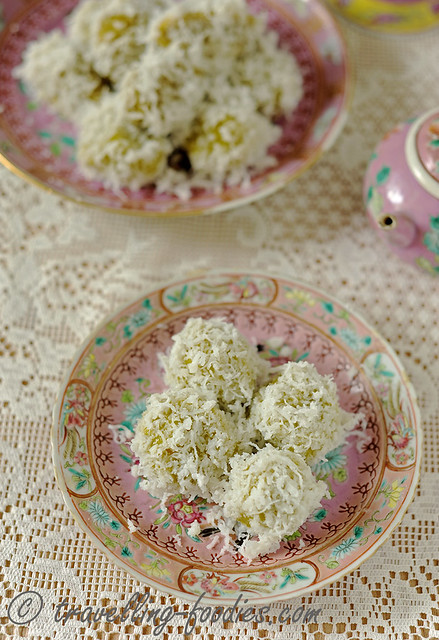
There are many kuehs which we grew up eating and enjoying, often not just because they taste good but also the other dimensions of the gastronomic experience that surpass that from just the palate that makes each bite memorable. Like lapis sagu or kueh lapis beras, which can be made more fun by peeling the kueh layer by layer, or in the case of ondeh ondeh, the sheer joy one receives as every one of these sticky and chewy balls explodes with each mouthful to unleash an avalanche of sweet and savory juices from within…
(more…)
On the Trail of the Phoenix – Kueh Bongkong
This is one of the many a times when a craving becomes too strong for one to withstand or hold back for another day. One of those I just have to “make and take a bite” moments. Saw my good friend Poh Lin’s mum Nyonya Guek made kueh bongkong just the other day and I wanted a bite of it so so badly. It is yet another kueh which I don’t make as often as I should. Then again, there are simply too many kuehs to make often to start with. It is not a difficult kueh to make, but for me, it is one which is difficult to master. Read on to find out why…
Chap Goh Meh & the Peranakan Pengat

Today is the 15th day of the Lunar New Year, which is known as 元宵节 Yuan Xiao Jie to the Chinese. To the traditional babas and nyonyas, this day also marks the end of the almost 2 month long preparation which started at 冬至 Tang Chek, followed by making kueh bakol for ari datok naik, Semayang Abu or ancestral prayers on the eve of the Lunar New Year, and then celebrations of the Lunar New Year itself. It continues on with ari datok turun on the 4th day, and then Semayang Teekong starting on the night of the 8th day of the Lunar New Year where kueh koo merah are made as an offering, and finally today, which is known as Chap Goh Meh to the Peranakan Chinese.
(more…)
On the Trail of the Phoenix – Kueh Dadar Chelop Kuah Santan
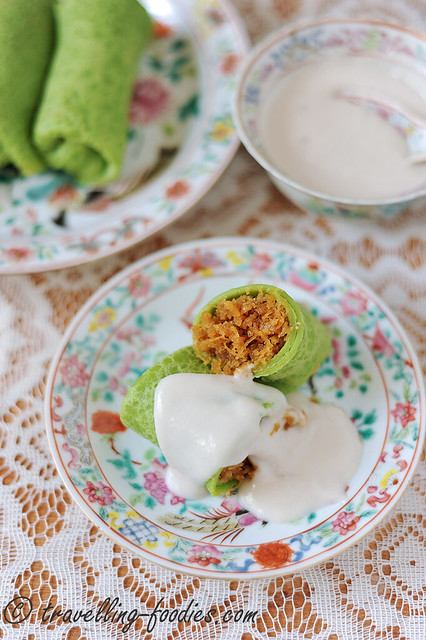
Kueh dadar is one of my favorite kueh, which we enjoyed tremendously as children as I’d mentioned in this post two years back. Known also as kuih ketayap, kuih gulung or kuih lenggang to some Malay communities, it is also a kueh which I revisit very often in my kitchen, sometimes eaten just on its own, or when I’m up for something more elaborated or wish for greater contrariety, a savory kuah santan would be quickly prepared using the leftover coconut milk from the batter to “chelop” the kueh dadar in. If the American kids grew up dunking Oreos in a glass of milk, kueh dadar chelop kuah santan must definitely be part of the wonderful childhood memories Peranakans have collectively.
On the Trail of the Phoenix – Apom Balek Durian

Peranakan desserts and snacks are such a large and colourful collection of delectables that they warrant special attention on their own. Being a unique group with members from such different backgrounds and rich heritage, the sweet and savory treats which signify the Peranakan community are exemplary of this wonderful diversity. Look closely, and one would be able to identify easily the cultural elements from the origins of forebears where the Peranakan roots developed from. Just to name a few, we have Kueh Koo Merah and Popiah from the Chinese, Rempah Udang, Pulot Inti with Malay-Indonesian influences, Pang Susi and Kueh Blanda with Portuguese-Dutch origins and of course Roti Babi from the proximal colonial links, and these are only a teeny tip of the iceberg of the repertoire affectionately known as “Kueh Chuchi Mulot” to the babas and nyonyas.
Many of these kuehs apart from tasting really good, are symbolic with their cultural significance tightly woven into the customs and practices of the Peranakan tapestry of life in the yesteryears. Some are prepared specially for specific occasions, like kueh bakol for the Chinese New Year, and were enshrouded with much mysticism through a relay of “patangs” (taboos) which had to be observed to strict accordance for guaranteed success in their making. Some like kueh koo itam were made almost exclusively for ancestral worship and serving them during other joyous or celebratory events would only invite “koosmangat!” from the nyonyas with their overtly animated and dramatised “terpranjat” look, not forgetting a string of gossips that would soon follow and before long the extended family or even the whole community would know who “kentot“. Many of these kuehs, like kueh koo, kueh sarlat (gading galoh), kueh lapis beras (kueh genggang) are “colour coded”, so it mattered to many Peranakans “what” to serve “when”, to “whom” and in “which colour”. Like many of the earlier mentioned kuehs with specific “functions”, apom balek is no exception.
On the Trail of the Phoenix – Bubur Cha Cha Durian
Bubur Cha Cha or “Bubor Cha Cheir” as it is known to some Peranakans, is a dessert soup which comes close to heart for my family. My mum loved it immensely and made it often enough for us to develop a liking for it as well since young. It is a chuchi mulot which she would exercise her creativity in the ingredients to be added depending on the amount of time she had at hand and of course what we loved to eat. Kept minimalistic, it would simply be just a sweet coconut milk broth base with diced kledek (sweet potato) and keladi (taro) cooked in it. More elaborated, an assortment of other “accessories” like bijik sagu kechik (small sago pearls), and legumes like kacang merah (red beans), kacang ijo (green beans) or kacang mata itam (black-eyed peas) can be cooked separated and added. Our favorite condiment must surely be sagu gunting, chewy morsels made from either sago flour or tapioca flour that look like gems sparkling in a pool of ingredients coated with a riot of psychedelic colours. Sometimes fruits will be added, mostly pisang (bananas), occasionally nangka (jackfruit) or even cempedak, and of course whenever it is in season, durian!
(more…)
On the Trail of the Phoenix – Sago Gula Melaka
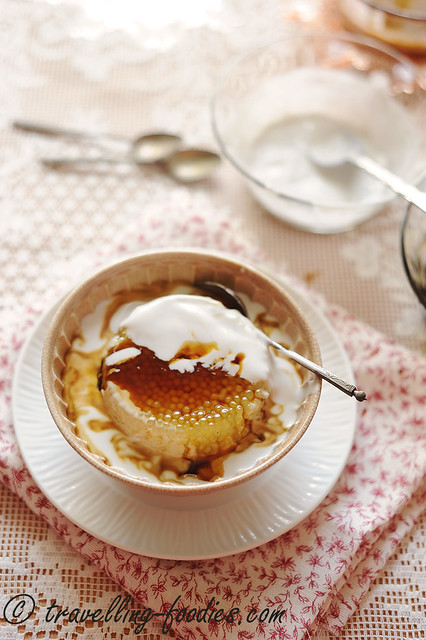
The weather has been somewhat erratic and unforgiving of late, tormentous heat wave for the last 2 weeks or so making the days go by in an utmost unbearable manner and then came the torrential rain yesterday afternoon. Despite the downpour, the cool-down it provided was only short-lived and temporal as it is back to another stuffy and hazy day. In need of something cold and refreshing, I made another favorite Peranakan chuchi mulot of mine for some instant relief. Looks like I’m on a dessert making spree! Sago Gula Melaka is incredulously easy to prepare and can be made way ahead. Just barely 30 min of work last night before going to bed and I’m ready to indulge in all that santan and gula melaka goodness this afternoon!
(more…)
On the Trail of the Phoenix – Pengat Pisang

Peranakan cuisine is well-known for its assortment of kuehs and sweet dishes, otherwise known as “chuchi mulot“. Most appropriately known as “palate cleansers” as many of these desserts, packed with much of their rich and sugary goodness break the monotony of the earlier main course dishes which are already imbued with much piquant flavours in spicy, savory and tang. The balance they provide brings about much contrast to the earlier dishes in a meal, and at the same time adding more experiential dimension and depth to the overall palate sensation, not to mention a resounding conclusion to an often hearty meal.
Bubor Cha Cha, Chendol and Pulot Itam, just to name a few, are some of the favorite chuchi mulots around, but my absolute “to cook the soonest and enjoy the fastest” so as to to curb that sweet tooth craving, has to be Pengat Pisang.
(more…)
On the Trail of the Phoenix – Apom Balek Nyonya
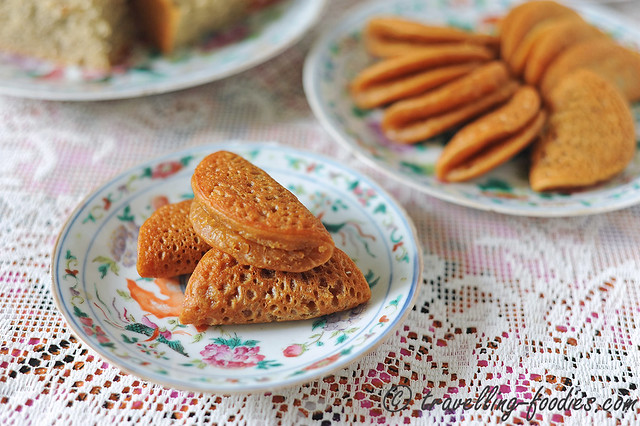
A short post to document an experiment as I was trying out a recipe for the Peranakan version of “apom balek“. Unlike the crispy and thin “apam balik” we typically see at the Malay food stalls in pasar malams, or the thick Chinese version called “min chiang kueh” we eat for breakfast, this version favoured by the Peranakans in Malacca and Singapore are much smaller and more dainty. Despite using the same mould, I don’t make apom balek as often as I do for apom berkuah, simply because I very much prefer the latter, especially with the irresistible kuah pengat pisang to go along. Nonetheless, I feel I do need to practice making this kueh which is important in many aspects of the Peranakan culture. So on goes with the experiment!
(more…)
Apom Berkuah… A Pictorial Guide
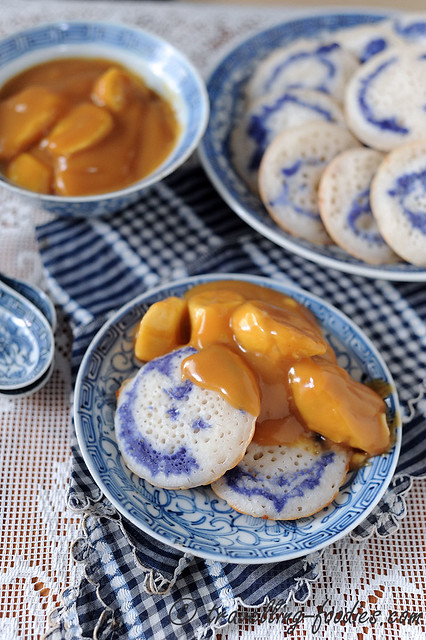
Apom Berkuah is one of my favorite kuehs and I try to make it whenever time avails. Despite being a Peranakan signature “cuchi mulot“, I believe that it has its roots in Indonesian cuisine where it is known by another name Kue Serabi, and variations likening surabi or srabi. Even amongst Peranakan communities in Singapore, Malacca and Penang, the pronunciation also differ slightly from Apom Berkuah, to Apom Bokwa and Apom Bengkua. To the Malays from Kedah, Malacca and Sabah, it is called “Kuih Serabai“,with a slightly phonological shift in the terminal syllable, where it transits to become a diphthong in place of the short monophthongal vowel, a linguistic nuance we commonly observe across many Bahasa Melayu to Baba Patois lexicographical pairs. The word “Apom” which was derived from “appam“, a south Indian pancake popular in Kerala and Tamilnadu, is sometimes spelt as “apong” instead. Despite the numerous names, one thing remains the same for this kueh, and that is how delicious they are! So let’s see how we make them!
(more…)
Rujak Kedondong Ulek Terasi – Spicy Indonesian Fruit Salad
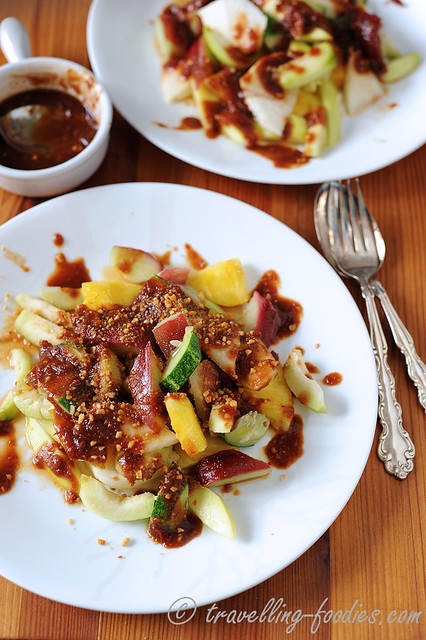
This is my first food post in the longest time. In fact, I’d neglected my blog for more than a month, being engaged in several events and activities, but mostly due to laziness actually. Indonesian month for AFF is coming to an end soon. So I better put up my posts before it is too late!
On the Trail of the Phoenix – Apom Berkuah

I love watching cooking shows on TV when I was young. Apart from learning through observing my grandmother, mother and aunties cook and helping them in the kitchen, part of what I know on traditional cooking came from these wonderfully made TV programmes, especially those on Channel 12 which later became Art Central. That was way before the time of reality cooking shows like Masterchef where drama seems to take centrestage instead of the food. And it was easily 10-15 years ago as even Arts Central has now become part of history to make way for “Okto”. That was when my TV watching days were over.
Almost 10 years ago, there was a series of TV programmes featuring Peranakan culture and cuisine. Most memorable were “The Ways of the Matriarch”, “The Cook, His Food and the Dishy Nyonyas” as well as “On the Trail of the Phoenix”. It is the last after which the Peranakan dishes presented in this blog were named as It was through these TV programmes that I’d learnt much about the intricacies of Straits Chinese cuisine and its preparation. One of the most impressionable dishes being showcased was Apom Berkuah, I remembered vividly the contrasting swirls of blue from juice extracted from bunga telang against the ivory colored fluffy rice cakes. After all these years, I’d finally gotten a chance to make them myself. Truly sedap!
(more…)
Kueh Dadar – My First Video Tutorial Guide

Kueh Dadar, is yet another popular ” nyonya kueh” snack which many of us grew up eating. Better known as “Kuih Ketayap” or simply “Kuih Tayap” this snack of Malay origin was part of the “3 for $1” assortment of kuehs available at pasar malam stalls especially at the raya bazaar during the Ramadan fasting month. While my mum would take the opportunity to shop and browse for new curtains, cushion covers etc, I would just “jalan jalan” along with her and my aunties munching on kueh dadar and other snacks. My cousins and I would deliberately choose different kuehs so that we would have a much larger range which we could share amongst ourselves than when we would be able to have it on our own. I remember fondly how we bellowed in exclamation, shouting at each other in our colloquial tongue “Eh, not fair lah! I also never eat so big piece from yours hor!” as we took turns to munch on each other’s kueh, screaming at each other for taking bites purportedly larger than what we had previously taken from the each other’s stash. All part of the fun of growing up!
Essentially a rolled up crepe with grated coconut filling cooked in coconut sugar, they are no longer available at that kind of prices anymore of course. In fact what one has to pay for these delectable morsels of sweet and rich kuehs have escalated so much especially over the last couple of years make me wonder if I should even buy them outside anymore. Yummilicious yes but wallet damaging… hence began my experimentation on making these kuehs on my own, starting with my favorite ondeh ondeh and my mum’s favorite kueh lapis. Unlike traditional peranakan or malay cooking which may ask for a wide variety of components especially in the making of the rempah, i.e. spice paste, nyonya kuehs usually require only a small handful of ingredients making them much more approachable. Hence I’d made a few videos as part of a tutorial guide for this lovely snack which I enjoy very much, in hope that you too like me, would begin your journey of making nyonya kuehs on your own.
Kuih Kosui

Kuih Kosui are little steamed rice cakes with a fudge-like texture, characterised by the wonderful aroma and flavours of gula melaka. I’d made these together with Onde Onde last weekend because they share a common final procedure, i.e. to be rolled in grated coconut before serving. Moreover, both are rather easy and require little time to prepare. And of course, both include the liberal use of gula melaka, one of my favorite ingredients in the pantry.
Ondeh Ondeh

Ondeh Ondeh is a traditional “kueh” which many of us grew up snacking. I remember first having it in primary school during recess time at the school canteen which we called “tuckshop” then. The “makan melayu” food stall, operated by an old Malay couple sold mainly local Malay delights like nasi lemak and lotong. But my eyes are always glued to the assortment of homemade”kuih muih” in psychedelic colours, almost a dozen of varieties that rotated down the week, with 2-3 types available daily. Most of my classmates and friends love to buy their kueh lapis beras, and for obvious reasons. They would peel and eat them by the layer, just like what we would do at home with my mum and sister. While I love to eat their kuehs, it was more of an indulgence rather than a necessity, given the limited amount of pocket money we had. But I’d always looked forward to the day when mee rebus was on the “Special of the Day” menu, because I know that one of my favorite kuehs would also be available, and that is of course, ondeh ondeh.
(more…)
On the Trail of the Phoenix – Nyonya Apom Balik Durian

One of the highlights of Straits Chinese cuisine is the wide selection of little bite-size steamed sweetcakes known as “kueh“, and like many other signature dishes in peranakan cooking, many of these kuehs are heavily “borrowed” from the culinary heritage of other ethnicities within the region, nyonya kueh is no exception. While Kueh Angku is uniquely chinese, others like rempah udang, pulut inti and seri muka have distinct roots in Malay and Indonesian cuisine. Some of them, like pineapple tarts have become fully adapted and so immensely popular as a nyonya delight that one would have easily forgotten their true origins.
Apom balik is a popular snack in many Asian cultures. And it comes in so many forms, shapes and sizes. Malays make a crispy and paperthin version no more than 6 inches wide, filled with shredded coconut cooked in gula merah, or chopped peanuts with granulated sugar. Chinese folks call them 面浆粿 ban chiang kueh or min chiang kueh depending on the dialectal origins, and make them lebih besar, using pans sometimes as wide as 2 feet in diameter! The folded pancake can be filled with a paste with chunky peanut butter-like consistency, or another chinese favorite, red bean paste. In recent years, we also see a version containing cheese! Whichever the version might be, I enjoy them all, especially for breakfast, to go with a warm glass of soya bean milk or teh tarik! But the version that remains close to my heart is nyonya apom balik, something which I’d enjoyed very infrequently as a childhood treat. It is the one traditional kueh which was most neglected, but not entirely forgotten as I still crave for them til today.
On the Trail of the Phoenix – Pengat Durian

The warm drafts of heat that overwhelms one has reached a point of becoming unbearable. Its almost impossible to be outdoors without breaking out in sweat, which at times can escalate levels of discomfort that makes surviving each dawn til dusk under such a turmoil a daily miracle. On a lighter and more positive note, not all about the heat is bad. Summer is the time for sunshine, blue clear waters, sandy beaches and bikini babes. But my mind is set on a different “catch”. The scorching months of late May to September bring with them a plethora of fruits, i.e. mangoes in all sorts of varieties, stone fruits of every thinkable species, but most importantly, it is the durian season again!
On the Trail of the Phoenix – Babi Pongteh

For me, the Peranakan culture is probably the most intriguing bit of Southeast Asian history. There are so many stories and theories which attempt to explain their origins but none so far has been rock solid. And precisely because of this shroud of vagueness that lends the Peranakan heritage a veil of mystery. Yet, the inter-marriage between the Chinese and Malays then yielded the “Straits Chinese” community which encapsulates the very essence of these two cultures, alongside influences from the Indians and even Europeans which colonised this part of the world. It is this “melting pot” of cultural and historical bearings that nurtured the Peranakan culture to be rich and colorful as we know it today. Through their architecture and handicraft like sewing and beadwork, we saw how the Peranakans brought together elements of the East and West and slowly over generations yielded it to become their uniquely own. But personally, I feel that the spirit of Peranakan culture, like many other cultures, lies in their food.
My first experience with Peranakan food outside of the household was actually at the most uncanny of all places, Pow Sing Chicken Rice 報喜 at Serangoon Gardens. Their chicken rice is fairly decent but unfortunately the same cannot be said for the standard of the Nyonya dishes on their menu. Alas, the quality of the food wasn’t fantastic but the liberal use of tau cheo (fermented bean paste) in addition to a hoard of spices, and the eccentricity of buah keluak’s appearance which can only be matched with its taste… the dining experience left quite an impression, both good and bad…
(more…)



